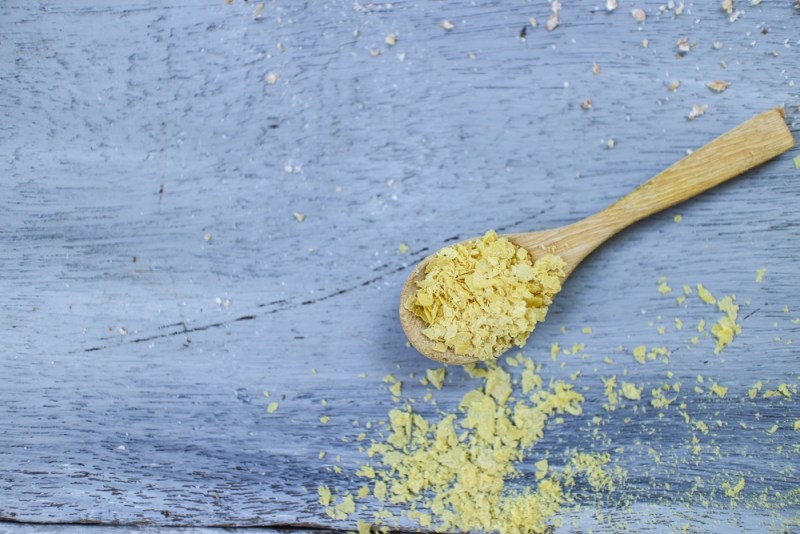Nutritional yeast is the substitute every vegan, vegetarian, and lactose intolerant deserves. If you’re craving cheese, nutritional yeast may be the best option to replace your parmesan shakers and kick your delicious dairy cravings to the curb. So, what is this flavor enhancing nutritional yeast?
What is Nutritional Yeast?
Nutritional yeast, sometimes called “nooch”, is a popular and trendy cheese alternative. It consists of dried, deactivated yeast, usually in large flaky form.
How It’s Made
This food additive is made from saccharomyces cerevisiae, a single-celled organism. It is grown on molasses then harvested, washed, and dried with heat to “deactivate” it. Since the saccharomyces cerevisiae is inactive, it doesn’t grow like baking yeast, so it won’t leaven. Fear not, animals are not harmed in the process of making nutritional yeast because yeasts are members of the fungi family, like mushrooms.
Nutritional Yeast Breakdown:
- 60 calories
- 8g protein
- 3g fiber
- 11.85 mg thiamine/vitamin B-1
- 9.70 mg riboflavin/vitamin B-2
- 5.90 mg vitamin B-6
- 17.60 mcg vitamin B-12

What Does It Taste Like?
Nutritional yeast has a nutty, creamy, cheesy taste, and is becoming a mainstream health food. It has been described to have a much more savory taste, in fact, flavors can be enhanced and form a rich flavor base simply by adding a small amount of nutritional yeast to a dish. It’s most commonly added into soups, gravies, and can make cheese sauces or even eggless scrambles taste cheesy. It’s readily available at local health food stores and grocery stores, or online. Our favorite brands are Bragg’s or Bob’s Red Mill.
Benefits of Nutritional Yeast
As previously listed, nutritional yeast contains B vitamins and fiber but it also boosts immunity, and aids digestion. Nutritional yeast offers a wide variety of health benefits. One of the major benefits is that the savory, umami taste of nutritional yeast comes from glutamaic acid. Glutamaic acid is an amino acid that is formed during the drying process of making nutritional yeast. Glutamic acid is a naturally occurring amino acid found in many fruits and vegetables but it is not the same as the commercial additive monosodium glutamate.

Nutritional yeast is a complete protein. It contains all nine amino acids that we need from food. In fact, just one tablespoon of nutritional yeast contains 2 grams of protein. This creates an easy opportunity for vegans and vegetarians to have high-protein meals. It also contains animal-based vitamins that vegans and vegetarians would not acquire otherwise.
Unfortified vs. Fortified Nutritional Yeast
The two ways nutritional yeast are generally made influence the overall health benefits of the additive. Fortified nutritional yeast is more common. The difference between the two is pretty straightforward.
Unfortified: This method does not contain any added vitamins or minerals. It only contains the vitamins and minerals that are naturally produced by the yeast cells as they grow.
Fortified: This type contains synthetic vitamins added during the manufacturing process to boost nutrient content. The ingredients list will include vitamins that have been added to the yeast.
How do you use it?
Nooch can be used in so many inventive ways! If you’re new to testing out nutritional yeast, it may be best to try a little bit at a time. Here are some simple ways to introduce nutritional yeast into your everyday life:
- Sprinkle on popcorn
- Stir into mashed potatoes
- Add into the cooking water for “cheesy grits”
- Add a sprinkle or two to top off pastas
Pro tip: Please note that because this yeast is inactive, it cannot be utilized to make bread rise or in baking like traditional yeast.

Drawbacks of Nutritional Yeast
Nutritional yeast is a valuable addition to many diets, however, there may be some side effects associated with using it as a dietary supplement that everyone should be aware of.
Digestive Side Effects and Intolerance
Nutritional yeast is packed with fiber and although a high-fiber diet can promote bowel regularity, eating too much too fast can cause some unfortunate side effects. Abdominal discomfort such as cramps or even diarrhea can occur if nutritional yeast is consumed in high amounts too quickly. It’s best to slowly introduce this additive into your diet so your body can adjust accordingly.
In addition to being cautious about the consumed amount of nutritional yeast, some people may be intolerant to nutritional yeast. This intolerance is more commonly found in those who have irritable bowel disease or Crohn’s disease. Symptoms included weight loss, severe diarrhea, and fatigue.
Facial Flushing
Niacin is also a source found in nutritional yeast. Niacin, or vitamin B3, is involved in vital processes in your body, such as metabolism and enzyme function. In one tablespoon of nutritional yeast, there are over 38 mg of niacin which nearly doubles the daily serving. Ingesting too much niacin can result in facial flushing. Facial flushing is a flush of red on the skin, which can be followed by a burning and itching sensation that occurs within 10–20 minutes.
Triggering Headaches or Migraines
Nutritional yeast truly is a great source of many vitamins and minerals, however, some yeast products can include compounds such as tyramine and monosodium glutamate (MSG). These compounds may trigger migraine attacks in some individuals. MSG is a popular food additive used to enhance flavor, however many people report MSG as a migraine trigger. Tyramine may cause migraine attacks in certain people as well.
